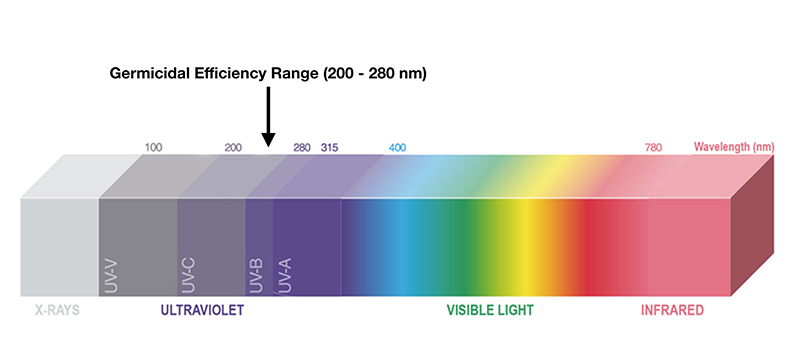Ultraviolet Light: Applications in Architecture
October 2020
“I’d put my money on the sun and solar energy, what a source of power.” - Thomas Edison, 1931
Were Thomas Edison, the Father of Invention, alive today, he would most likely be leading the pack on today’s ultraviolet light research and development. For over 100 years, the sun has been known as a powerful germ killer and bleaching agent. In 1877, British researchers discovered that dirty test tubes could be sterilized by the natural disinfectant effects of the sun. By the 1930s, Harvard was using UV lighting in classrooms to cut the rate of measles infections among students.
Ultraviolet light can be used to kill viruses and bacteria in the air, on surfaces, and in water systems. This practice is known as Ultraviolet Germicidal Irradiation (UVGI). UVGI neutralizes microorganisms by damaging DNA and corrupting the genetic code; the same basic process by which the sun damages skin cells in humans. Hospitals have used ultraviolet light to disinfect surgical spaces for years. Sometimes germicidal UV light is distributed throughout large areas by robots. Smaller applications are done with the use of a wand. These applications, however, must be done when spaces are unoccupied due to the fact that excessive exposure to UV light can cause skin cancer and damage to the eyes.

Today, researchers are refocusing these efforts on combating the coronavirus. Recent research has discovered that there is a spectrum of UV light that can kill the coronavirus without harming humans. This UV light is a narrow slice of the spectrum known as Far-UVC, with wavelengths between 207nm and 220 nm. Dr. David Brenner, PhD and Director of Columbia University’s Radiological Research Center, has been working on Far-UVC sterilization technology for five years.[1] After the conclusion of safety and efficacy testing and FDA approval, the biggest hurdle to widespread distribution is production. Manufacturers will have to ramp up production in order to meet the demand.
The implications of this new lighting technology are easy to imagine. Architects will soon be specifying this technology into hospitals, senior care centers, schools, arenas, theaters, airports, hospitality, restaurants, offices, and anywhere people gather indoors. Imagine Far-UVC lights with built-in motion sensors around building entryways. Architects have always known the importance of correct lighting for indoor space. Now architects will also be specifying lighting that not only illuminates space, but also keeps occupants safe from biological threats in the air and on surfaces.
In recent news we have learned that The Blind Horse Restaurant and Winery in Kohler, Wisconsin will become the first restaurant in the United States to install Far-UVC Lighting technology for real time mitigation of harmful pathogens and viruses. This sanitary lighting solution was developed by Healthe, Inc. in Melbourne, Florida. “The suite of safety protocols and technology that we are installing is extensive and unprecedented in our industry. We are pound to at the forefront in utilizing this technology in the restaurant and winery industry,” said Thomas Nye, General Manager and Master Winemaker. The Blind Horse will install 18 ceiling-mounted, Healthe Space™ lights that produce a combination of general illumination and Far-UVC 222 sanitizing light to clean the air and surfaces. [2]
For additional information, see the following:
- David Brenner, Covid-19 Virtual Symposium: April 8, 2020
https://www.youtube.com/watch?v=4iJuSNI3Y98 - Far-UV Light and Covid-19, Dr. Eddie Fatakhov, Board Certified Internist
https://www.youtube.com/watch?v=XWPXTSA-ILQ - Press release by Kate Kaminski
https://theblindhorse.com/media/ - Heathe, Inc.
https://healtheinc.com/
[1] Jackie Drees, Becker's Hospital Review (Ultraviolet Technology Shine New Light on Covid-19 Infection Prevention, April 10, 2020)
[2] Kate Kaminski, Press Release, October 13, 2020